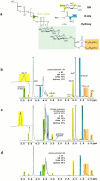Structure-function relationship of cytokine induction by lipoteichoic acid from Staphylococcus aureus
- PMID: 11157059
- PMCID: PMC2195914
- DOI: 10.1084/jem.193.3.393
Structure-function relationship of cytokine induction by lipoteichoic acid from Staphylococcus aureus
Abstract
Lipoteichoic acids (LTAs) have been proposed as putative Gram-positive immunostimulatory counterparts to Gram-negative lipopolysaccharides. However, LTA from Staphylococcus aureus, the clinically most frequent Gram-positive pathogen, was inactive after purification. Here, a novel isolation procedure to prepare pure (>99%) biologically active LTA, allowing the first structural analysis by nuclear magnetic resonance and mass spectrometry, is described. A comparison with LTA purified by standard techniques revealed that alanine substituents are lost during standard purification, resulting in attenuated cytokine induction activity. In line with this finding, hydrolysis of alanine substituents of active LTA decimated cytokine induction. LTA represents a major immunostimulatory component of S. aureus.
Figures



Similar articles
-
Definition of structural prerequisites for lipoteichoic acid-inducible cytokine induction by synthetic derivatives.J Immunol. 2003 Apr 15;170(8):4134-8. doi: 10.4049/jimmunol.170.8.4134. J Immunol. 2003. PMID: 12682244
-
Differential immunostimulatory effects of Gram-positive bacteria due to their lipoteichoic acids.Int Immunopharmacol. 2009 Jan;9(1):127-33. doi: 10.1016/j.intimp.2008.10.014. Epub 2008 Nov 14. Int Immunopharmacol. 2009. PMID: 19013542
-
Structure/function relationships of lipoteichoic acids.J Endotoxin Res. 2005;11(6):348-56. doi: 10.1179/096805105X67328. J Endotoxin Res. 2005. PMID: 16303090 Review.
-
Synthetic lipoteichoic acid from Staphylococcus aureus is a potent stimulus of cytokine release.J Exp Med. 2002 Jun 17;195(12):1635-40. doi: 10.1084/jem.20020322. J Exp Med. 2002. PMID: 12070290 Free PMC article.
-
Interactions between lipoteichoic acid and peptidoglycan from Staphylococcus aureus: a structural and functional analysis.Microbes Infect. 2002 Jul;4(9):927-35. doi: 10.1016/s1286-4579(02)01620-9. Microbes Infect. 2002. PMID: 12106785 Review.
Cited by
-
Cell activation by ligands of the toll-like receptor and interleukin-1 receptor family depends on the function of the large-conductance potassium channel MaxiK in human macrophages.Infect Immun. 2006 Jul;74(7):4354-6. doi: 10.1128/IAI.01783-05. Infect Immun. 2006. PMID: 16790810 Free PMC article.
-
The phosphatidylinositol 3-kinase/protein kinase B signaling pathway is activated by lipoteichoic acid and plays a role in Kupffer cell production of interleukin-6 (IL-6) and IL-10.Infect Immun. 2004 Oct;72(10):5704-11. doi: 10.1128/IAI.72.10.5704-5711.2004. Infect Immun. 2004. PMID: 15385469 Free PMC article.
-
Toll-like receptor 4 (TLR4)-deficient murine macrophage cell line as an in vitro assay system to show TLR4-independent signaling of Bacteroides fragilis lipopolysaccharide.Infect Immun. 2002 Sep;70(9):4892-6. doi: 10.1128/IAI.70.9.4892-4896.2002. Infect Immun. 2002. PMID: 12183533 Free PMC article.
-
Muramyl dipeptide synergizes with Staphylococcus aureus lipoteichoic acid to recruit neutrophils in the mammary gland and to stimulate mammary epithelial cells.Clin Vaccine Immunol. 2010 Nov;17(11):1797-809. doi: 10.1128/CVI.00268-10. Epub 2010 Sep 8. Clin Vaccine Immunol. 2010. PMID: 20826612 Free PMC article.
-
Role of Toll-like receptors 2 and 4 in pulmonary inflammation and injury induced by pneumolysin in mice.PLoS One. 2009 Nov 24;4(11):e7993. doi: 10.1371/journal.pone.0007993. PLoS One. 2009. PMID: 19956717 Free PMC article.
References
-
- Zivot J.B., Hoffmann W.D. Pathogenic effects of endotoxin. New Horiz. 1995;3:267–275. - PubMed
-
- Rietschel E.T., Brade H., Holst O., Brade L., Muller-Loennies S., Mamat U., Zahringer U., Beckmann F., Seydel U., Brandenburg K. Bacterial endotoxinchemical constitution, biological recognition, host response, and immunological detoxification. Curr. Top. Microbiol. Immunol. 1996;216:39–81. - PubMed
-
- Neely J.L. Staphylococcus aureusa continuing problem. WV Med. J. 1994;90:238–241. - PubMed
-
- al-Ujayli B., Nafziger D.A., Saravolatz L. Pneumonia due to Staphylococcus aureus infection. Clin. Chest Med. 1995;16:111–120. - PubMed
-
- Bone R.C. Gram-positive organisms and sepsis. Arch. Intern. Med. 1994;154:26–34. - PubMed
MeSH terms
Substances
LinkOut - more resources
Full Text Sources
Other Literature Sources
Molecular Biology Databases

